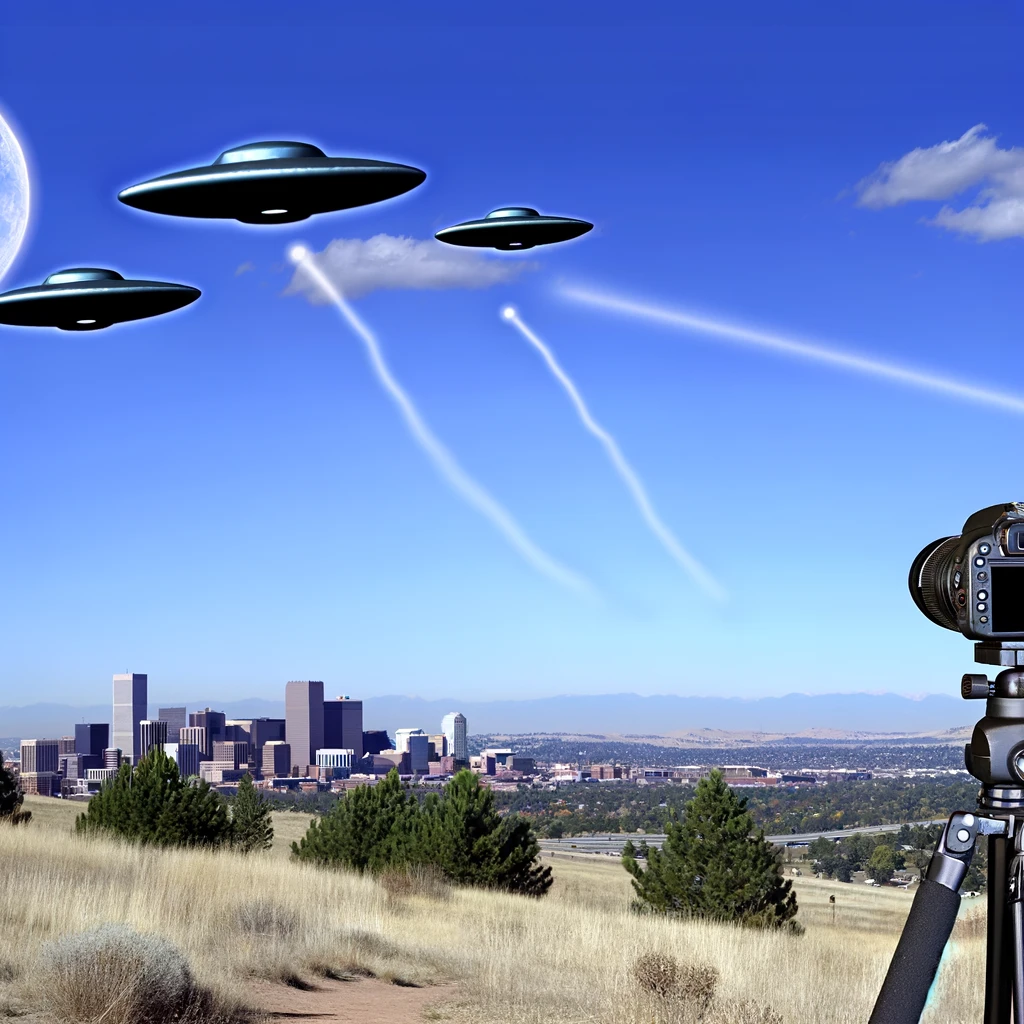UFO filmed by News Station in Denver Incident (2012)

In November 2012, a curious incident captured the attention of many when a Denver news station reported on unidentified flying objects (UFOs) that were not visible to the naked eye but could be observed through slowed-down video footage. A local resident, preferring to remain anonymous, brought his home video to the news station, which showed peculiar fast-moving objects in the sky above Denver. Captured from a hilltop in Federal Heights, the footage depicted these objects performing unusual maneuvers, such as sudden bursts that resembled thrusters and looping movements, typically around midday.
The camera used to capture the footage of the unidentified flying objects was set up on a hilltop in Federal Heights, specifically looking south towards downtown Denver. The footage mentions that “Mile High is right about here,” suggesting the proximity to Mile High Stadium, which is a landmark in Denver. The exact location for the camera setup was described as being on 84th and Federal, which provides a vantage point from which the Denver metro area can be observed. This location was chosen to replicate the conditions under which the original footage was taken by the metro area man who first reported the sightings.
The phenomenon sparked interest due to its inexplicable nature; even an aviation expert, Steve Cowell, who is a former commercial pilot and FAA accident prevention counselor, was unable to identify the flying objects. After examining the footage, Cowell confirmed that the objects did not resemble any known aircraft or birds, and their speeds surpassed those of conventional aircraft, making them difficult to detect with the naked eye.
The news station’s own photojournalist set up a camera at the same location to verify the resident’s claims and managed to capture similar unidentified objects on video. Despite slowing down the footage for a clearer view, the objects’ origins and nature remained a mystery. The Federal Aviation Administration (FAA) and the North American Aerospace Defense Command (NORAD), both of which monitor air traffic, reported no unusual activity or sightings in the area during the specified times.
The human eye and camera sensors capture and process light and motion in fundamentally different ways, which can lead to discrepancies in what they can detect, especially when it comes to fast-moving or faint objects such as the UFOs reported in the Denver incident.
Human Eye Limitations:
- Persistence of Vision: The human eye has a limitation known as the “persistence of vision,” where images linger on the retina for about 1/25th to 1/15th of a second. This means that very fast-moving objects, particularly those that do not stay in the field of view for long enough, can be difficult or impossible for the human eye to detect and process.
- Temporal Resolution: The human eye can generally process only 10 to 12 separate images per second as individual frames. Objects moving significantly faster than this can appear as a blur or might not be registered at all.
- Sensitivity to Light: The human eye is less sensitive to dim light and small contrasts compared to many camera sensors. Fast-moving objects that do not emit or reflect much light might not be visible to the naked eye, especially against a bright background like the sky.
Camera Capabilities:
- Shutter Speed: Cameras, especially those used by professionals, can have very high shutter speeds, allowing them to capture images in a fraction of a second (1/1000th of a second or faster). This enables cameras to capture very fast-moving objects that the human eye might miss.
- Frame Rate: Video cameras can record at high frame rates, significantly higher than the temporal resolution of the human eye. For example, a camera recording at 60 frames per second or higher can capture more details of fast-moving objects, making them visible when the video is played back slowly.
- Sensitivity and Adjustment: Cameras can adjust their sensitivity to light (ISO) and aperture to capture more details in varying light conditions. This makes them more adept at capturing faint or fast-moving objects under different lighting conditions than the human eye.
Blurriness of Captured UFOs:
Despite the advantages of camera equipment, the captured UFOs could still appear blurry due to several factors:
- Motion Blur: Even with high shutter speeds, extremely fast-moving objects can still appear blurred in the direction of motion due to the limited exposure time of each frame.
- Focus: Capturing fast-moving objects, especially at a distance, can be challenging in terms of maintaining sharp focus, particularly if the object’s distance from the camera changes rapidly.
- Resolution and Zoom: Details of distant objects might be lost if the camera’s resolution is not high enough or if digital zoom (which can degrade image quality) is used instead of optical zoom.
- Atmospheric Conditions: Variations in air density, heat haze, and other atmospheric conditions can distort light and make distant objects appear blurry in photographs and videos.
The combination of these factors contributes to the difficulty in clearly capturing and identifying fast-moving objects like the reported UFOs with camera equipment, even though cameras may detect them more readily than the human eye.
Speculations arose about the possible explanations for these sightings, ranging from secret military tests to atmospheric debris, yet none could conclusively explain the high-speed, unidentified objects. The local resident who first reported the sightings believed that these UFOs were launching and landing near a residential area in Denver, adding another layer of intrigue to the story. Despite various theories, the true nature of these objects remains an unresolved mystery, leaving many to wonder about the activities in the skies above Denver.


